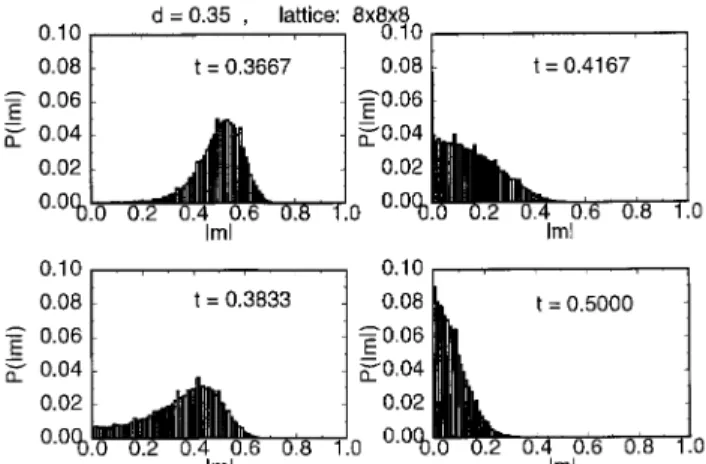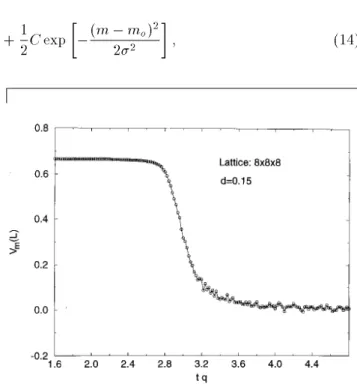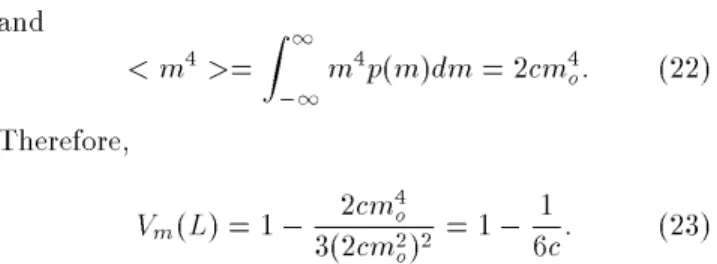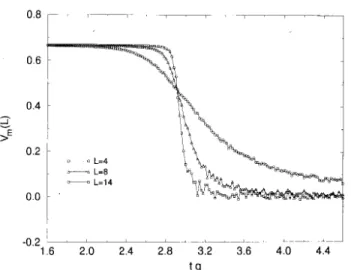Fourth-Order Cumulants to Characterize the
Phase Transitions of a Spin-1 Ising Model
Shan-HoTsai InstituteforTheoreticalPhysics
StateUniversityofNewYork StonyBrook,N.Y.11794-3840,USA
and S. R.Salinas InstitutodeFsica UniversidadedeS~aoPaulo
CaixaPostal66318 05315-970,S~aoPaulo,SP,Brazil
ReceivedOctob er6,1997
Fourth-order cumulants of physical quantities have been used to characterize the nature of a phase transition. In this paper we report some Monte Carlo simulations to illustrate the behavior of fourth-order cumulants of magnetization and energy across second and rst-order transitions in the phase diagram of a well known spin-1 Ising model. Simple ideas from the theory of thermodynamic uctuations are used to account for the behavior of these cumulants.
I Introduction
There are many attempts to characterize the order of a phase transition on the basis of the analysis of nu-merical data obtained from simulations of nite spin systems. One of the approaches to this problem con-sists in the analysis of the behavior of fourth-order cu-mulants of physical quantities (as the order parame-ter and the energy) associated with the systems under consideration[1, 2]. Properties of the fourth-order cu-mulants of magnetization (and energy) have been in-vestigated in the context of nite-size eects in mag-netically (and thermally) driven rst-order transitions in Ising and Potts models[3, 4, 5, 6] (as well as in the case of some other systems[7, 8]).
In this paper, we perform Monte Carlo simulations for the well known Blume-Capel model[9, 10] to il-lustrate the behavior of the fourth-order cumulants of magnetization and energy across rst and second-order transitions in the phase diagram of this system. We show that it is possible to draw some conclusions from
the study of relatively small lattices. The general fea-tures of the cumulants can be accounted for by simple arguments from the theory of thermodynamic uctua-tions. In particular, we emphasize the dierences be-tween the two types of cumulants, and the alternative denitions of the cumulant of energy (which has not been fully appreciated in previous investigations).
The layout of this paper is as follows. In Section 2 we dene the cumulants of a physical quantity. In Sec-tion 3 we introduce some further deniSec-tions, and dis-cuss some properties of the Blume-Capel model. Simu-lations for the fourth-order cumulants of magnetization and energy are reported in Sections 4 and 5, respec-tively. We hope to have provided another example of the use of these cumulants to characterize the order of a phase transition.
II Denition of the cumulants
c
< exp (x) >= 1+ < x > +12 < x2
> +16 < x3
> + 124 < x4> +::: ; (1) where the brackets denote an average[11]. If we keep terms up to fourth order, the logarithm of this expansion may be written as
lnf< exp (x) >g=< x > +12Q
2+ 16Q3+ 124Q4+ ::: ; (2)
where the cumulants Q2, Q3, and Q4, are given by Q2=< x
2>
,< x >
2; (3)
Q3=< x 3>
,3 < x >< x
2> +2 < x >3; (4)
and
Q4=< x 4>
,3 < x 2>2
,4 < x >< x
3> +12 < x >2< x2>
,6 < x >
4: (5)
d These cumulants can be rewritten in the more compact form,
Q2=< (x
,< x >)
2>; (6)
Q3=< (x
,< x >)
3>; (7)
and
Q4=< (x
,< x >) 4>
,3 < (x,< x >)
2 >2: (8) Also, the fourth-order cumulant Q4 is more often writ-ten as
Vx(L) = 1,
< (x,< x >L) 4>
L
3< (x,< x >L) 2>
2
L; (9)
where L is the linear size of the lattice under consider-ation.
III The Blume-Capel model
The Blume-Capel model is given by the spin Hamilto-nian
H=,J X
(i;j)
SiSj+ DXN i=1
S2 i ,H
N X i=1
Si; (10)
where Si = +1;0;,1, on sites i = 1;:::;N of a Bravais lattice, and the rst sum is performed over all pairs of nearest-neighbor sites. We consider the ferromagnetic case, with positive exchange (J > 0) and anisotropy (D > 0) parameters, which gives rise to a competition between distinct spin orderings. In the D=J versus T=J
space, where T is the absolute temperature, the phase diagram consists of an ordered and a disordered phase separated by a transition line that changes character from rst to second{order at a well dened tricritical point. We use this model to illustrate the behavior of the fourth-order cumulants.
In zero eld, the ordered phase is characterized by symmetric magnetizations, +m0 and
,m
0, with the same energy. In general, we havehHiL 6= 0, and even hHniL 6= 0, for all n. Therefore, the fourth-order cu-mulant of energy is written as
VE(L) = 1,
< (H,<H>L) 4>
L
3< (H,<H>L) 2>
2
L; (11)
where L is the linear size of the lattice. As the magne-tization is symmetric, that is, < mn>L= 0 for n odd,
the fourth-order cumulant of the magnetization is given by
Vm(L) = 1,
< m4> L
3< m2> 2
L: (12)
It should be remarked that, as < En >L6= 0 for all n (including odd values of n), and < mn>L= 0 for odd
n, the energy and the magnetization give rise to distinct expressions of the fourth-order cumulant.
t T
J ; d
D
J ; and h H
J ; (13) and use a Metropolis algorithm to perform Monte Carlo simulations for the Blume-Capel model, in zero eld, on a simple cubic lattice of side L.
Figure 1. Histogram of the absolute values of the magneti-zation,jmj, across a rst-order phase transition.
In Fig. (1), we show the distribution of the absolute values of the magnetization for t = 0:1667, L = 8, and several values of d. In the top left graph, for d = 0:5000, jmj has a unique maximum around jmj = 0:9, which corresponds to an ordered phase. The bottom left graph, for d = 0:5008, displays two peaks (around m = 0 andjmj = 0:9), which indicate the coexistence of phases (m = 0, and m =m
0
6
= 0). Upon increas-ing the value of d, the peak at jmj = 0 is enhanced, while the peak around jmj= 0:9 is depressed (see the top right graph, for d = 0:5017). For even larger val-ues of d, there remains a single peak around jmj= 0, which indicates that the system is in the paramagnetic phase (see the graph for d = 0:5050). This set of graphs represents a rst-order transition.
Figure 2. Histogram of the absolute values of the magneti-zation,jmj, across a second-order phase transition.
In Fig. (2), we show a histogram of jmj across a second-order transition, for d = 0:35. The top left graph, for t = 0:3667, corresponds to the ordered phase, with a single peak of the absolute value of the magne-tization at jmj = 0:5. As the value of t is increased, this peak moves toward jmj = 0 and no other peak arises (see the lower left graph, for t = 0:3833). For higher values of t,jmjpeaks atjmj= 0 (see the graphs at right, for t = 0:4167 and t = 0:5000). This set of graphs illustrates a continuous phase transition.
Figs. (1) and (2) provide the motivation for choos-ing a Gaussian form for the probability of magne-tization, p(m). Although we are showing data for the magnetization, similar histograms can be built for the energy, which also give support to a Gaussian-shaped probability distribution, p(E). For large lat-tices (L!1) these distributions are expected to tend to Dirac delta functions. The thermodynamic consis-tency of these assumptions has been discussed in detail by Challa, Landau, and Binder[4] (see also the work of Oitmaa and Fernandez[12]).
Now we present separate analyses of the fourth-order cumulants associated with magnetization and en-ergy across rst and second-order phase transitions.
IV Cumulants of magnetization
In the ordered phase the distribution of probability of the magnetization consists of two peaks around +m0 and ,m
c
p(m) = 12Cexp ,
(m + mo)2 22
+ 12Cexp ,
(m,mo) 2 22
; (14)
d where C = (22),1=2is a normalization constant, and the parameter should be inversely proportional to the lattice volume, L3. In the L
!1limit, we have two Dirac delta functions,
p(m)! 1
2(m + mo) + 12(m,mo) : (15) For nite lattices, with p(m) given by Eq. (14), we have < mn>= 0, for odd values of n, and
< m2>= Z
1
,1
m2p(m)dm = 2+ m2
o; (16)
and
< m4>= Z
1
,1
m4p(m)dm = 34+62m2 o+m4
o: (17)
Thus, the fourth-order cumulant is given by Vm(L) = 1,
34+ 62m2 o+ m4
o
3(2+ m2
o)2 : (18) In the disordered phase, p(m) has a single peak at m0 = 0. Inserting m0 = 0 in Eq. (18), we have Vm(L) = 0 for the disordered phase.
For innite lattices (! 0), it is easy to see that Vm(L)!2=3 in the ordered phase. In the disordered phase, Vm(L)!0, regardless of the value of the param-eter . These limiting values for the innite lattice also come from the double-delta distribution p(m), given by Eq. (15). In this case, in the ordered phase, we have < mn>= 0, for odd n, and < mn>= mno for even n.
Thus
Vm(L)!1, m4
o
3(m2
o)2 = 23: (19) In the disordered phase, < mn >= 0 for all n, hence
Vm(L)!0.
Figure 3. Fourth-order cumulant of the magnetization ver-sus temperature,tq, across a second-order phase transition.
Monte Carlo data were obtained for the Blume-Capel model on a cubic lattice (q= 6) of sideL= 8, ford= 0:15.
Av-erages were calculated from 50000 Monte Carlo steps after thermalization.
In a second order phase transition, the two peaks of the distribution of probabilities p(m) in the ordered phase move towards each other and form a unique peak at m = 0 as the system passes to the disordered phase. Fig. (3) shows the cumulant of magnetization for the Blume-Capel model in a second order phase transition. These simulations were performed for a cubic lattice of side L = 8 (and coordination q = 6), at d = 0:15. We have run 5000 times through the lattice to reach thermalization. Each average was then calculated us-ing 50000 additional steps.
In a rst-order phase transition we have the coexis-tence of the ordered and disordered phases. The distri-bution of probabilities p(m) has peaks at m =m
0
6
= 0, and m = 0. For an innite lattice, we take the triple-delta distribution,
p(m) = c(m+mo)+c(m,mo)+(1,2c)(m) ; (20) where c is a positive constant. We then have
< m2>= Z
1
,1
m2p(m)dm = 2cm2
Therefore,
Vm(L) = 1,
2cm4 o
3(2cm2 o)2 = 1
, 1
6c: (23)
For small values of c, namely c < 1=6, the cumulant Vm(L) is negative. Similar results could have been
ob-tained from the L ! 1 limit of a Gaussian form of p(m) for a nite lattice. In Fig. (4), we show the fourth-order cumulant of the magnetization across a rst-fourth-order phase transition. The simulations were performed for a cubic lattice, with L = 8, at t = 0:15. We have run 5000 steps through the lattice to reach thermalization. Each average was then calculated from 50000 additional steps. In the ordered phase, we do have Vm(L) = 2=3.
In the disordered phase there are very smalluctuations around Vm(L) = 0. At the transition, Vm(L) assumes
a negative value.
Figure 4. Fourth-order cumulant of magnetization versus anisotropy, dq, across a rst-order phase transition. Monte
Carlo data were obtained for the Blume-Capel model on a cubic lattice (q= 6) of sideL= 8, at temperaturet= 0:15.
Averages were calculated from 50000 Monte Carlo steps af-ter thermalization.
V Cumulants of energy
In both ordered and disordered phases, the probability distribution of energy has a unique peak at a certain value, which we call E0. For small lattices, we can write the Gaussian form
p(E) = C exp
,
(E,Eo) 2 22
; (24)
p(E)!(E,Eo): (25)
From Eq. (24), we obtain < E >=Z
1
,1
Ep(E)dE = Eo; (26)
< (E,< E >) 2>=
Z 1
,1
(E,Eo)
2p(E)dE = 2; (27) and
< (E,< E >) 4>=
Z 1
,1
(E,Eo)
4p(E)dE = 34: (28) Inserting these expressions into Eq. (11), we have
VE(L) = 1, 34
3(2)2 = 0; (29) for all values of the parameter (that is, independently of the size of the lattice used in the simulation). Using the limiting distribution, given by Eq. (25), we also have
< E >! Z
1
,1
E(E,Eo)dE = Eo; (30) and
< (E,< E >)n>! Z
1
,1
(E,Eo)n(E,Eo)dE = 0; (31) for all n. Hence, VE(L) !0, as we have already ob-tained.
Figure 5. Fourth-order cumulant of energy versus temper-ature, tq, across a second-order phase transition. Monte
Carlo data were obtained for the Blume-Capel model on a cubic lattice (q = 6) of side L = 8, ford = 0:15.
In a second-order transition the distribution p(E) displays just a single peak, that moves from an initial valueE
1to a nal value E
2. Therefore, the cumulant of energy across a second-order transition always vanishes, independently of the lattice size. The Monte Carlo es-timates ofVE(L) for the Blume-Capel model, as shown in Fig. (5), ford= 0:15 and lattice sizeL= 8, indicate a small maximum next to a small minimum near the second-order phase transition. This behavior suggests that it becomes too simple to describe the probabilities
in the immediate neighborhood of a continuous transi-tion by a symmetric Gaussian form. This is also hinted by the bottom left graph of Fig. (2), which is already quite asymmetric.
In a rst-order phase transition there is a coexis-tence between the ordered phase, associated with a dis-tribution of energy peaked at E
1, and the disordered phase, with a distribution peaked atE
2. Then, we can write
c
p(E) =c(E,E 1) + (1
,c)(E,E 2)
; (32)
from which we have
<E>= Z
1
,1
Ep(E)dE=cE 1+ (1
,c)E 2
; (33)
<(E,<E>) 2
>= Z
1
,1
[E,cE 1
,(1,c)E 2]
2
p(E)dE=c(1,c)(E 1
,E 2)
2
; (34)
and
<(E,<E>) 4
>= Z
1
,1
[E,cE 1
,(1,c)E 2]
4
p(E)dE= =c(1,c)(1,3c+ 3c
2)( E
1 ,E
2) 4
: (35)
d The fourth-order cumulant is given by
VE(L) = 2, 1 3c(1,c)
; (36)
which becomes negative for small values of either c or 1,c. In Fig. (6), for a cubic lattice of size L = 8, at t= 0:15, we show the fourth-order cumulant associ-ated with the energy of the Blume-Capel model across a rst-order phase transition.
In Figs. (7) and (8), we illustrate the fourth-order cumulants of magnetization and energy across a second-order transition. We see that the cumulants Vm(L), for dierent values of L, cross at a unique point, which can be used to estimate the transition temperature[2, 6, 7, 13]. However, it should be pointed out that a precise location of the transition requires a detailed study of nite size scaling, which is beyond the scope of this paper[2, 3, 4, 6, 14, 15, 16].
Figure 6. Fourth-order cumulant of energy versus the pa-rameter of anisotropy,dq, across a rst-order phase
transi-tion. Monte Carlo data were obtained for the Blume-Capel model on a cubic lattice (q= 6) of side L= 8, at
tempera-turet= 0:15. Averages were calculated from 50000 Monte
Figure 7. Fourth-order cumulant of magnetization ver-sus temperature,tq, across a second-order phase transition
(d = 0:15), for the Blume-Capel model on a sequence of
cubic lattices (q= 6), of lattice sizesL= 4, 8, and 14. The
Monte Carlo averages were calculated from 50000 lattice steps after thermalization.
Figure 8. Fourth-order cumulant of energy versus tempera-ture,tq, across a second-order phase transition (d= 0:15),
for the Blume-Capel model on a sequence of cubic lattices (q= 6), of lattice sizesL= 4, 8, and 14. The Monte Carlo
averages were calculated from 50000 lattice steps after ther-malization.
Many authors use a fourth-order cumulant of the energy given by the form
V E(
L) = 1, <E
4 >
L 3<E
2 >
2 L
; (37)
instead of the connected expression of Eq. (11). Al-though this may work for Ising and Potts models[17], it is important to emphasize that for the Blume-Capel model we have to use the correct denition, given by Eq. (11), to be able to extract the order of the phase transition (see also the recent works of Janke[18], and of Borgs and collaborators[16]).
We have used the spin-1 Ising model of Blume and Capel to illustrate the feasibility of characterizing the order of a phase transition from a simple analysis of the behavior of the fourth-order cumulants of energy and magnetization. The general features of these cumulants can be derived from simple arguments of the theory of thermodynamic uctuations. In the literature, there are two denitions of the fourth-order cumulant of en-ergy. We have pointed out that, in the case of systems as the Blume-Capel model, it is important to consider the connected form of the cumulant of energy.
Acknowledgments
We acknowledge helpful discussions with C. E. I. Carneiro. This work was supported by grants from Fapesp and CNPq.
References
[1] K. Binder, Phys. Rev. Lett.47, 693 (1981).
[2] K. Binder, Z. Phys. B43, 119 (1981).
[3] K. Binder and D. P. Landau, Phys. Rev. B30, 1477
(1984).
[4] M. S. S. Challa, D. P. Landau, and K. Binder, Phys. Rev. B34, 1841 (1986).
[5] A. Billoire, R. Lacaze, A. Morel, S. Gupta, A. Irback, and B. Petersson, Phys. Rev. B42, 6743 (1990).
[6] K. Vollmayr, J. D. Reger, M. Scheucher, and K. Binder, Z. Phys. B91,113 (1993).
[7] K. Binder and D. W. Heermann, Monte Carlo Simu-lations in Statistical Physics, Springer-Verlag, Berlin, 1988.
[8] N. Caticha, J. Chahine, and J. R. Drugowich de Felicio, Phys. Rev. B431173 (1991).
[9] M. Blume, V. J. Emery, and R. B. Griths, Phys. Rev. A4, 1071 (1971).
[10] M. N. Tamashiro and S. R. A. Salinas, Physica A211,
124 (1994).
[11] S. K. Ma, Statistical Mechanics, World Scientic, Sin-gapore, 1985.
[12] J. Oitmaa, J. F. Fernandez, Phys. Rev. B39, 11920
(1989).
[14] K. Binder, M. Nauenberg, V. Privman, and A. P. Young, Phys. Rev. B31, 1498 (1985).
[15] J. Lee and J. M. Kosterlitz, Phys. Rev. B43, 3265
(1991).
[16] C. Borgs, P. E. L. Rakow and S. Kappler, J. Phys. I
France , 1027 (1994).
[17] J. F. McCarthy, Phys. Rev. B41, 9530 (1990).




